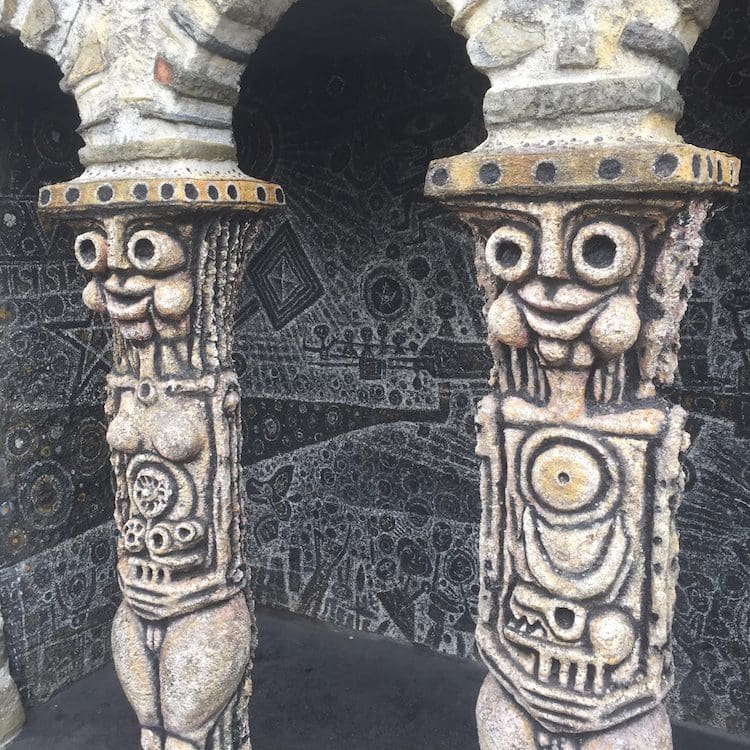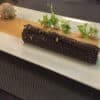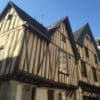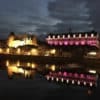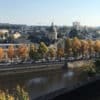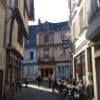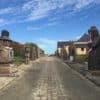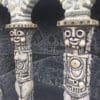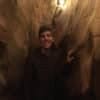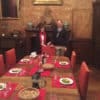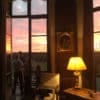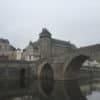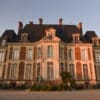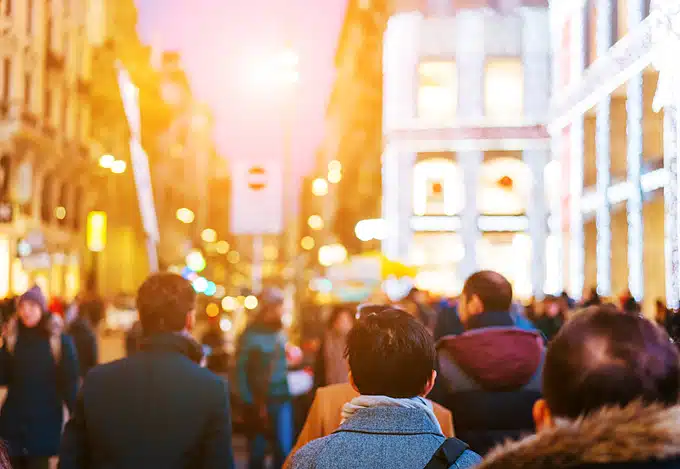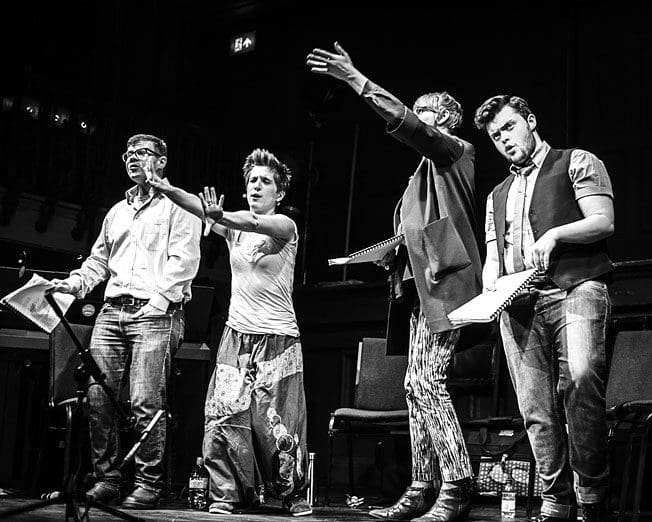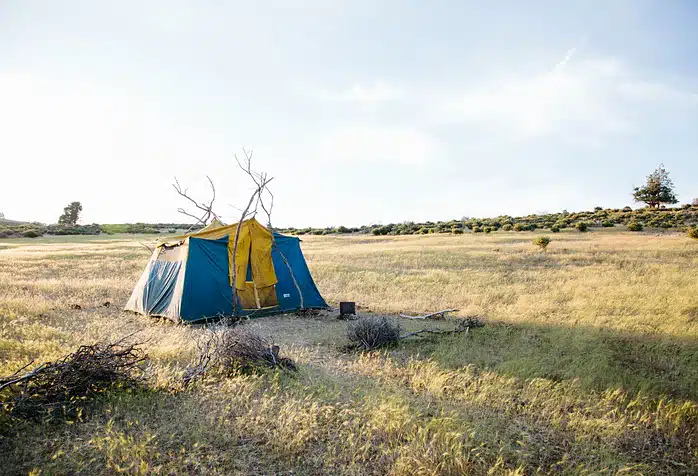Words: Chris Zacharia
Entering a cave isn’t something you just do. You have to prepare yourself for the cold, the dark, the damp – and unexpected surprises.
But when, half an hour later, the halo of our guide’s flashlight reveals a hellish, lopsided swastika scratched into the rockface, I’m shocked. Somehow, this symbol of human arrogance and disaster is rendered still bleaker by its mysterious presence, two hundred metres deep into one of northwest France’s most famous caves.
- Robert Tatin’s Walkway of Giants
- Robert Tatin’s Meditation Garden
- Exploring Mayenne’s caves
- Thibault and Aude, serving dinner
- Sunset from the Chateau Mazure
- Robert Tatin’s dragon
- Laval, as seen from the river Mayenne
- Chateau Mazure
‘We treat all the art in the cave with the same care’ our guide explains. ‘All of it is part of our history’
I’m in the Mayenne, a tranquil patch of the Loire Valley, in leisurely pursuit of slow tourism. No busy shopping streets, no traffic, no bustle. The Mayenne is a land where the old ways of doing things thrive, where the past is protected – faded swastika included.
This eerie echo of the German occupation was etched by a Nazi search party in 1940, convinced that the French freedom fighters were hiding themselves or their weapons in the caves near Saulges. Fortunately, a few wobbly steps away is a second, more hopeful engraving: an American soldier, writing his name into the region’s history four years later. Clyde Culpepper, of Birmingham, Alabama, USA, still visible in the dark belly of the cave.
For history buffs, this is fascinating, but there’s we’re still more awestruck by the prehistoric art. In a cramped, rocky corridor, our guide flashes his torch upon the ancient wall. Tenderly, he points: the unmistakable outline of a rhinoceros, telling us that someone, long ago, felt the urge to express themselves.
We stand gazing at the simple shape of the rhino, stunned. To observe human creativity from so far back, from a time that neither historian nor scientist can convincingly recreate, is a humbling privilege. Witnessing our fledgling attempts at cultural expression inspires a fatherlike impulse, making you feel protective of mankind.
‘Although they look crude to us, these are actually very skilled’ our guide begins, ruining my paternalistic fantasy. ‘The artist had to trace the shape three times – a difficult task in such a small space’
Half an hour later, we emerge in the autumn sunshine of contemporary France, feeling extremely glad that it’s no longer the ice age. Families picnic in the lush green fields below the cave’s impressive rockface, untroubled by sabre-tooth tigers. A nearby museum enhances the experience, presenting flints, primitive tools and reproductions of Neanderthal skulls. The excited gasps of schoolchildren punctuate the displays.
Laval, the market-town capital of Mayenne, is a twenty-minute drive away. Steep, cobbled streets, woodbeamed sixteenth-century inns, and an imperious chateau-fortress lend Laval a dramatic aspect. The river Mayenne winds its way beneath the stone bridges, doubling the town’s spires and turrets in the pristine watery reflection.
Hiring a boat is an excellent way to explore the wooded valleys. Beginning in the countryside five miles upstream, our speedboat – courtesy of Anjou Navigation – cruises its way through the bends and ribbons, slicing the silky mists. Every so often we steer the boat into a lock, for quayman Hervé to raise us.
Making use of the boat’s bicycles, we disembark to cycle on a red-brown riverside path of fallen leaves, watching the boat losing and finding itself through the trees. It’s an idyllic way to spend the afternoon, the scene so flawlessly autumnal that it looks plucked from a catalogue of stock images.
But autumn isn’t just for cycling through. It’s also on our plates. That evening, we head to a rather unusual cookery class, held in a stunning chateau.
The Loire Valley is famous for its chateaus. These days, most of them are hushed museums, handled by the French authorities, hosting only group after group of gawping tourists.
But Château de la Mazure is different: it is home to a family, who have held this vast home since the early days of the 1900s.
‘A house like this is a big responsibility, believe me’ says Thibault, who looks a lot like Tintin’s worldly cousin. ‘The work never stops. This year, we’ve asked Santa for seven new windows. We can’t exactly go to IKEA!’ he quips.
With his eager wisecracking and gentle smile, Thibault is exactly the kind of bloke you’d want to inherit a mansion. His enthusiastic demonstrations of the wallpaper (leather), the staircase’s suit of armour (in the visor of which Thibault plans to hang the mandatory fire escape sign) and the dumb-waiter (still functional!) show that the magic of living inside a fairytale hasn’t worn off.
At Château de la Mazure, Thibault and his elegant, sharp-witted mother Aude invite guests to cooking-and-language lessons. The idea is simple. Small groups of six or less arrive at the Château, stay for a few days and cook authentic French dishes in the kitchen. The cooking is combined with lessons in French: Aude has been a teacher of languages for almost thirty years.
The Château is completely devoted to sustainability. Proudly, Thibault shows us the enormous organic vegetable garden, kept according to strict permaculture principles. Adjacent is the plant-based treatment site for the Château’s greywater, and next to that is a woodchip heating system. It’s all natural, and it’s all sustainable.
Down in the cavernous basement kitchen of flagstone and woodbeam, we’re given the chance to shape some of this fresh garden produce into something tasty. Tomatoes, carrots, parsnips and herbs all sit beneath the shadow of an enormous pumpkin.
Step by step, we set about turning it into a pie. My task is to beat the dough which will form the pastry, by slamming the pudgy ball around a tupperware, shaking my arms to rattle it around.
‘Good! More!’ Thibault’s mother encourages, watching me beadily. ‘From the top!’
‘La recette du Patrick devra etre realisee pour la repas du soir’ we reply in chorus.
Soon our pumpkin pie is in the oven, our smoked ham tartlets are crisping up nicely and we’ve learned three complete phrases. Upstairs, the doors of the drawing room are thrown open, allowing us to bask in a fiery pink sunset while drinking local cidre.
Our meal, upon a vast dining table in the elegant dining room, is well worth the effort. Ever the obliging hosts, Thibault and Aude draw each of us out in turn, so that by the end we feel like old friends. Slow tourism is agreeing with me.
The next morning, we start the day with a leisurely stroll through Laval’s Saturday market. Beneath a fleece of golden leaves, a maze of flowers, fromage, saucisson and cidre. After loading up on a particularly crisp, crunchy cidre, we drive out of the city, to the Musée Robert Tatin.
Tatin was an unconventional artist, whose lifetime of creative cross-pollinisation bestowed him with many skills. Tiler, sculptor, painter, architect: Tatin was a craftsman who travelled widely. After five years in South America, he decided to retire in his native Mayenne. It was in the countryside around Laval that he built his enduring masterpiece.
This isn’t an ordinary museum. Sure, there’s a visitor’s centre and a gift shop, but the Musée Robert Tatin is different. It starts with the Walkway of Giants. A procession of statues brackets the path. Some are caricatures of Tatin’s heroes (Joan of Arc, Pablo Picacco) while others are interpretations of concepts (To Have, which stands opposite To Be).
Tatin takes a wealth of symbols, from Yin and Yang to gambler’s dice, and combines them in such a way that feels fresh and insightful. At the end of the Walkway of Giants lies Tatin’s house: a visionary environment, surrounded by a breathtaking Garden of Meditation.
With a style reminiscent of pre-Colombian South America – Aztec bodies, Olmec heads – Tatin set about creating a spiritual ecosystem, a place where all of humanity’s religions can coexist. Much of Tatin’s varied and intriguing work pays homage to woman, variously mother nature and earth goddess. No wonder he married four times.
Exploring Tatin’s labyrinth of statues, triptychs and obelisks in the late afternoon sunshine is a magical experience. Around each corner is something incredible to behold: the mouth of a dragon, a hidden faun, a talismanic engraving. Inside, Tatin’s equally-impressive psychedelic paintings reward patient examination.
No matter how transcendental, art always leaves you hungry. We head back into Laval for a final meal at L’Esprit Cuisine. Despite the nondescript entrance, despite the low-key, business conference interior, the food is simply outrageous.
A six-course tasting menu acts as an glittering anthology of creative French cooking. Fried fois gras sits atop a bed of noodles in a seafood broth; a squid ink meringue with the texture of fairydust sweetens a rice cake of mackerel; aged beef, with a strong, almost cheesy flavour, is lifted to dizzying heights by the addition of a smear of black cherry and a heap of shaved manchego. A log of dark chocolate ganache, as thick as a cigar served on a shoreline of quince and partnered with walnut ice cream, has us in raptures.
Fantastic food, original art, and authentic French culture, all within la Mayenne’s peaceful enclave. Slow tourism might be sedate, but it’s never boring.
For more information about the Mayenne region, visit http://uk.france.fr/
To rent your own riverboat, go to anjou-navigation.fr/en/
Discover language and cooking classes at the Chateau Mazure at chateaulamazure.com/?lang=en

